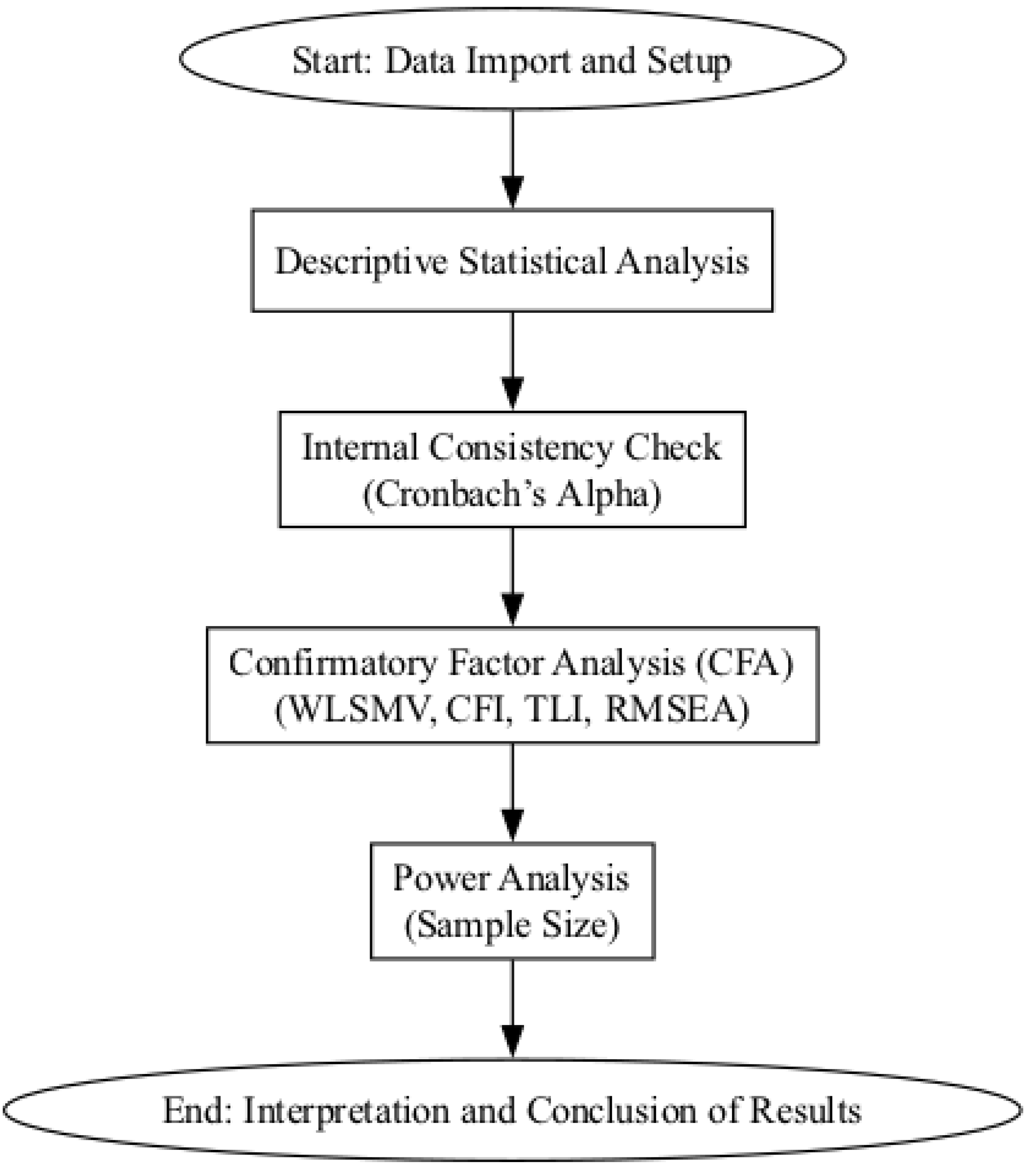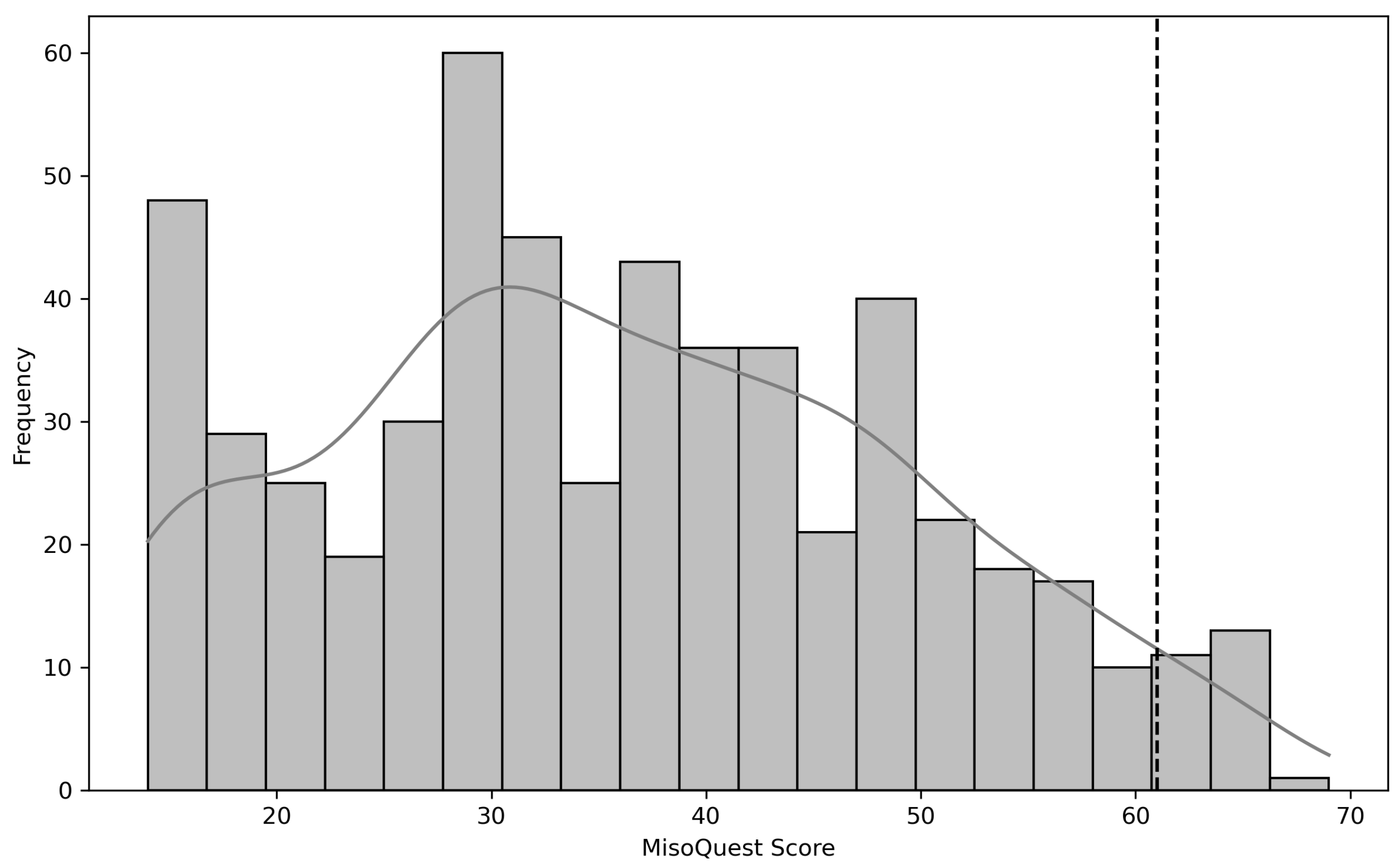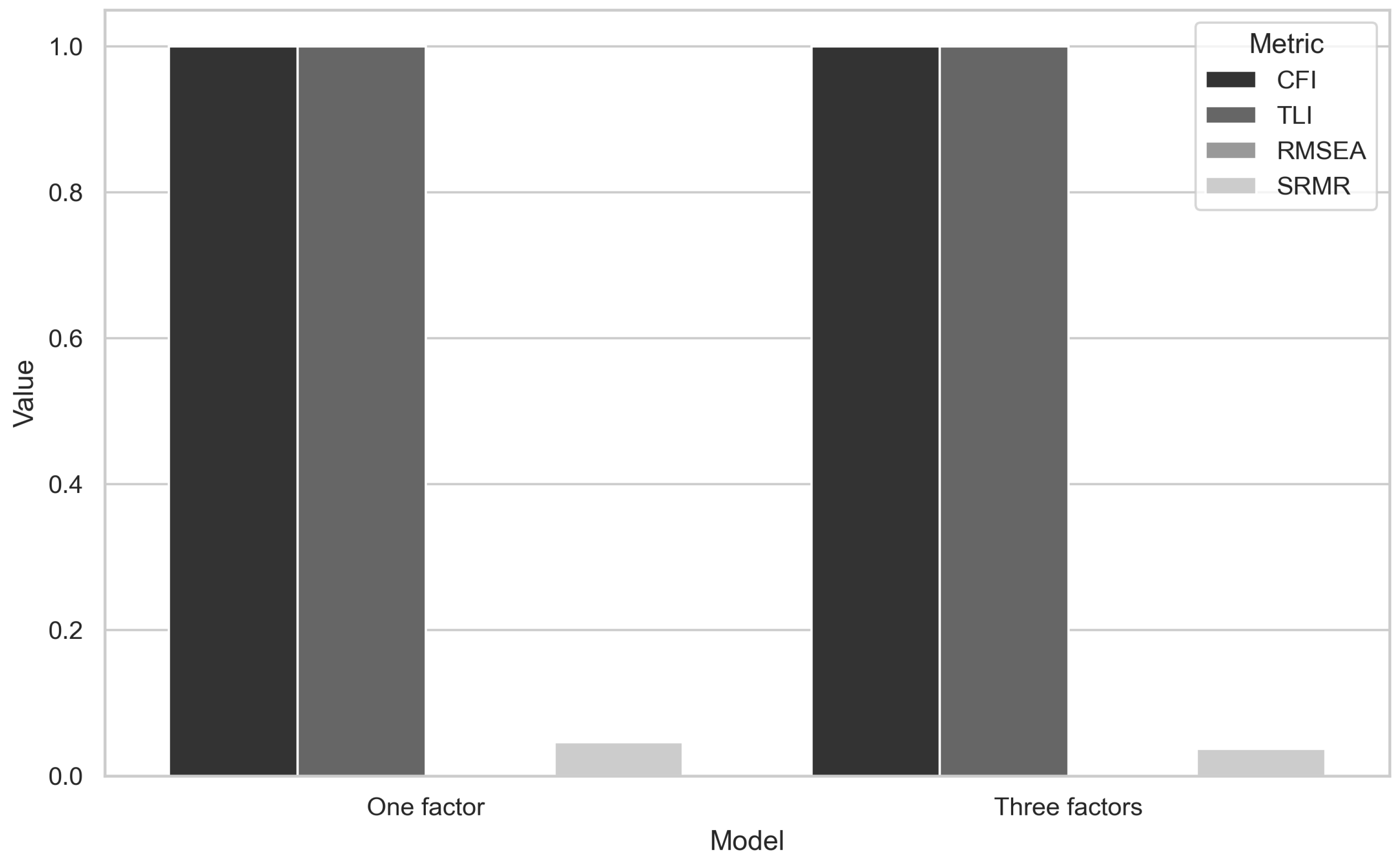Assessing Misophonia in Young Adults: The Prevalence and Psychometric Validation of the MisoQuest Questionnaire
Abstract
1. Introduction
2. Materials and Methods
2.1. Design
2.2. Participants
2.3. Online Assessments
2.4. Statistical Analysis
2.4.1. Descriptive Statistics
2.4.2. Internal Consistency Reliability
2.4.3. Factor Analysis
2.5. Power Analysis
3. Results
3.1. Misophonia Prevalence among Students via MisoQuest
3.2. Adequacy of Data for Factor Analysis
3.2.1. Exploratory Factor Analysis (EFA)
3.2.2. Factor Loadings and Communalities for MisoQuest Items
3.2.3. Confirmatory Factor Analysis (CFA)
3.2.4. Reliability Analysis
4. Discussion
5. Conclusions
6. Limitations
Supplementary Materials
Author Contributions
Funding
Institutional Review Board Statement
Informed Consent Statement
Data Availability Statement
Acknowledgments
Conflicts of Interest
References
- Jastreboff, M.M.; Jastreboff, P.J. Components of decreased sound tolerance: Hyperacusis, misophonia, phonophobia. ITHS Newsl. 2001, 1–5. [Google Scholar] [CrossRef]
- Edelstein, M.; Brang, D.; Rouw, R.; Ramachandran, V.S. Misophonia: Physiological investigations and case descriptions. Front. Hum. Neurosci. 2013, 7, 47988. [Google Scholar] [CrossRef] [PubMed]
- Edelstein, M.; Monk, B.; Ramachandran, V.; Rouw, R. Context influences how individuals with misophonia respond to sounds. bioRxiv 2020. [Google Scholar] [CrossRef]
- Swedo, S.E.; Baguley, D.M.; Denys, D.; Dixon, L.J.; Erfanian, M.; Fioretti, A.; Jastreboff, P.J.; Kumar, S.; Rosenthal, M.Z.; Rouw, R.; et al. Consensus definition of misophonia: A delphi study. Front. Neurosci. 2022, 16, 841816. [Google Scholar] [CrossRef]
- McKay, D.; Kim, S.K.; Mancusi, L.; Storch, E.A.; Spankovich, C. Profile Analysis of Psychological Symptoms Associated with Misophonia: A Community Sample. Behav. Ther. 2018, 49, 286–294. [Google Scholar] [CrossRef]
- Jager, I.; de Koning, P.; Bost, T.; Denys, D.; Vulink, N. Misophonia: Phenomenology, comorbidity and demographics in a large sample. PLoS ONE 2020, 15, e231390. [Google Scholar] [CrossRef]
- Sarigedik, E.; Gulle, B. A Study on Validation of Amsterdam Misophonia Scale in Turkish and Misophonia’s Prevalence in Turkish High School/College Student Population. Psychiatry Behav. Sci. 2021, 11, 258. [Google Scholar] [CrossRef]
- Schröder, A.; Vulink, N.; Denys, D. Misophonia: Diagnostic Criteria for a New Psychiatric Disorder. PLoS ONE 2013, 8, e54706. [Google Scholar] [CrossRef]
- Dozier, T.H.; Morrison, K.L. Phenomenology of Misophonia: Initial physical and emotional responses. Am. J. Psychol. 2017, 130, 431–438. [Google Scholar] [CrossRef]
- Eijsker, N.; Schröder, A.; Smit, D.J.; van Wingen, G.; Denys, D. Structural and functional brain abnormalities in misophonia. Eur. Neuropsychopharmacol. 2021, 52, 62–71. [Google Scholar] [CrossRef]
- Tunç, S.; Başbuğ, H.S. An extreme physical reaction in misophonia: Stop smacking your mouth! Psychiatry Clin. Psychopharmacol. 2017, 27, 416–418. [Google Scholar] [CrossRef]
- Kılıç, C.; Öz, G.; Avanoğlu, K.B.; Aksoy, S. The prevalence and characteristics of misophonia in Ankara, Turkey: Population-based study. BJPsych Open 2021, 7, e144. [Google Scholar] [CrossRef] [PubMed]
- Naylor, J.; Caimino, C.; Scutt, P.; Hoare, D.J.; Baguley, D.M. The Prevalence and Severity of Misophonia in a UK Undergraduate Medical Student Population and Validation of the Amsterdam Misophonia Scale. Psychiatr. Q. 2021, 92, 609–619. [Google Scholar] [CrossRef] [PubMed]
- Siepsiak, M.; Sobczak, A.M.; Bohaterewicz, B.; Cichocki, T.; Dragan, W.T. Prevalence of misophonia and correlates of its symptoms among inpatients with depression. Int. J. Environ. Res. Public Health 2020, 17, 5464. [Google Scholar] [CrossRef] [PubMed]
- Jakubovski, E.; Müller, A.; Kley, H.; de Zwaan, M.; Müller-Vahl, K. Prevalence and clinical correlates of misophonia symptoms in the general population of Germany. Front. Psychiatry 2022, 13, 1012424. [Google Scholar] [CrossRef] [PubMed]
- Vitoratou, S.; Hayes, C.; Uglik-Marucha, N.; Pearson, O.; Graham, T.; Gregory, J. Misophonia in the UK: Prevalence and norms from the S-Five in a UK representative sample. PLoS ONE 2023, 18, e0282777. [Google Scholar] [CrossRef]
- Zhou, X.; Wu, M.S.; Storch, E.A. Misophonia symptoms among Chinese university students: Incidence, associated impairment, and clinical correlates. J. Obs.-Compuls. Relat. Disord. 2017, 14, 7–12. [Google Scholar] [CrossRef]
- Rosenthal, M.Z.; McMahon, K.; Greenleaf, A.S.; Cassiello-Robbins, C.; Guetta, R.; Trumbull, J.; Anand, D.; Frazer-Abel, E.S.; Kelley, L. Phenotyping misophonia: Psychiatric disorders and medical health correlates. Front. Psychol. 2022, 13, 941898. [Google Scholar] [CrossRef]
- Jastreboff, P.J.; Jastreboff, M.M. Treatments for decreased sound tolerance (hyperacusis and misophonia). Semin. Hear. 2014, 35, 105–120. [Google Scholar] [CrossRef]
- Ferrer-Torres, A.; Giménez-Llort, L. Misophonia: A Systematic Review of Current and Future Trends in This Emerging Clinical Field. Int. J. Environ. Res. Public Health 2022, 19, 6790. [Google Scholar] [CrossRef]
- Brennan, C.R.; Lindberg, R.R.; Kim, G.; Castro, A.A.; Khan, R.A.; Berenbaum, H.; Husain, F.T. Misophonia and Hearing Comorbidities in a Collegiate Population. Ear Hear. 2024, 45, 390–399. [Google Scholar] [CrossRef] [PubMed]
- Siepsiak, M.; Sliwerski, A.; Dragan, W.T. Development and psychometric properties of misoquest—A new self-report questionnaire for misophonia. Int. J. Environ. Res. Public Health 2020, 17, 1797. [Google Scholar] [CrossRef] [PubMed]
- Van Rossum, G. Python programming language. In Proceedings of the USENIX Annual 514 Technical Conference, Santa Clara, CA, USA, 17–22 June 2007; Volume 41, pp. 1–36. [Google Scholar]
- Kluyver, T.; Ragan-Kelley, B.; Pérez, F.; Granger, B.; Bussonnier, M.; Frederic, J.; Kelley, K.; Hamrick, J.B.; Grout, J.; Corlay, S.; et al. Jupyter Notebooks—A publishing format for reproducible computational workflows. In Positioning and Power in Academic Publishing: Players, Agents and Agendas; IOS Press: Amsterdam, The Netherlands, 2016; pp. 87–90. [Google Scholar]
- Harris, C.R.; Millman, K.J.; van der Walt, S.J.; Gommers, R.; Virtanen, P.; Cournapeau, D.; Wieser, E.; Taylor, J.; Berg, S.; Smith, N.J.; et al. Array programming with NumPy. Nature 2020, 585, 357–362. [Google Scholar] [CrossRef] [PubMed]
- McKinney, W. Data Structures for Statistical Computing in Python. In Proceedings of the 9th Python in Science Conference, Austin, TX, USA, 28 June–3 July 2010; Volume 445, pp. 56–61. [Google Scholar] [CrossRef]
- Virtanen, P.; Gommers, R.; Oliphant, T.E.; Haberland, M.; Reddy, T.; Cournapeau, D.; Burovski, E.; Peterson, P.; Weckesser, W.; Bright, J.; et al. SciPy 1.0: Fundamental algorithms for scientific computing in Python. Nat. Methods 2020, 17, 261–272. [Google Scholar] [CrossRef] [PubMed]
- Ay, E.; Huviyetli, M.; Çakmak, E. The mediating role of anxiety in the relationship between misophonia and quality of life: Findings from the validated Turkish version of MisoQuest. Front. Psychol. 2024, 15, 1361645. [Google Scholar] [CrossRef]
- Hu, L.t.; Bentler, P.M. Cutoff criteria for fit indexes in covariance structure analysis: Conventional criteria versus new alternatives. Struct. Equ. Model. Multidiscip. J. 1999, 6, 1–55. [Google Scholar] [CrossRef]
- Kaiser, H.F. A second generation little jiffy. Psychometrika 1970, 35, 401–415. [Google Scholar] [CrossRef]
- Muthén, B.O. Goodness of fit with categorical and other nonnormal variables. SAGE Focus Ed. 1993, 154, 205. [Google Scholar]
- Enzler, F.; Fournier, P.; Noreña, A.J. A psychoacoustic test for diagnosing hyperacusis based on ratings of natural sounds. Hear. Res. 2021, 400. [Google Scholar] [CrossRef]
- Savard, M.A.; Sares, A.G.; Coffey, E.B.J.; Deroche, M.L.D. Specificity of Affective Responses in Misophonia Depends on Trigger Identification. Front. Neurosci. 2022, 16, 879583. [Google Scholar] [CrossRef]
- Wu, M.S.; Lewin, A.B.; Murphy, T.K.; Storch, E.A. Misophonia: Incidence, Phenomenology, and Clinical Correlates in an Undergraduate Student Sample: Misophonia. J. Clin. Psychol. 2014, 70, 994–1007. [Google Scholar] [CrossRef] [PubMed]
- Aryal, S.; Prabhu, P. Misophonia: Prevalence, impact and co-morbidity among Mysore University students in India-a survey. Neurosci. Res. Notes 2022, 5, 161. [Google Scholar] [CrossRef]
- Sujeeth, P.R.; Hanji, R.; Nayyar, K.; Prabhu, P. Estimation of Prevalence of Misophonia Among High School Students in India. Indian J. Otolaryngol. Head Neck Surg. 2024, 76, 1678–1681. [Google Scholar] [CrossRef] [PubMed]
- Kula, F.B.; Cropley, M.; Aazh, H. Hyperacusis and Misophonia: A Systematic Review of Psychometric Measures. J. Am. Acad. Audiol. 2023, 33, 417–428. [Google Scholar] [CrossRef]




| Items | Factor Loadings | Communalities |
|---|---|---|
| Q1 | 0.717 | 0.514 |
| Q2 | 0.600 | 0.360 |
| Q3 | 0.730 | 0.533 |
| Q4 | 0.772 | 0.597 |
| Q5 | 0.717 | 0.515 |
| Q6 | 0.711 | 0.505 |
| Q7 | 0.757 | 0.573 |
| Q8 | 0.708 | 0.502 |
| Q9 | 0.696 | 0.484 |
| Q10 | 0.742 | 0.551 |
| Q11 | 0.779 | 0.607 |
| Q12 | 0.792 | 0.627 |
| Q13 | 0.699 | 0.489 |
| Q14 | 0.769 | 0.591 |
| MisoQuest Items (n = 549) | Corrected Item–Total Correlation | F1 | F2 | F3 |
|---|---|---|---|---|
| Q1 | 0.644 | 0.691 | ||
| Q2 | 0.555 | 0.594 | ||
| Q3 | 0.677 | 0.726 | ||
| Q4 | 0.677 | 0.727 | ||
| Q5 | 0.643 | 0.686 | ||
| Q7 | 0.699 | 0.749 | ||
| Q6 | 0.664 | 0.712 | ||
| Q8 | 0.630 | 0.671 | ||
| Q9 | 0.658 | 0.700 | ||
| Q12 | 0.719 | 0.794 | ||
| Q14 | 0.694 | 0.762 | ||
| Q10 | 0.741 | 0.764 | ||
| Q11 | 0.650 | 0.740 | ||
| Q13 | 0.715 | 0.687 |
Disclaimer/Publisher’s Note: The statements, opinions and data contained in all publications are solely those of the individual author(s) and contributor(s) and not of MDPI and/or the editor(s). MDPI and/or the editor(s) disclaim responsibility for any injury to people or property resulting from any ideas, methods, instructions or products referred to in the content. |
© 2024 by the authors. Licensee MDPI, Basel, Switzerland. This article is an open access article distributed under the terms and conditions of the Creative Commons Attribution (CC BY) license (https://creativecommons.org/licenses/by/4.0/).
Share and Cite
Silva, L.d.A.; Noll, M.; Siqueira, G.C.; Barbosa, A.K.N. Assessing Misophonia in Young Adults: The Prevalence and Psychometric Validation of the MisoQuest Questionnaire. Healthcare 2024, 12, 1888. https://doi.org/10.3390/healthcare12181888
Silva LdA, Noll M, Siqueira GC, Barbosa AKN. Assessing Misophonia in Young Adults: The Prevalence and Psychometric Validation of the MisoQuest Questionnaire. Healthcare. 2024; 12(18):1888. https://doi.org/10.3390/healthcare12181888
Chicago/Turabian StyleSilva, Lourival de Almeida, Matias Noll, Gabriel Cunha Siqueira, and Alana Karolyne N. Barbosa. 2024. "Assessing Misophonia in Young Adults: The Prevalence and Psychometric Validation of the MisoQuest Questionnaire" Healthcare 12, no. 18: 1888. https://doi.org/10.3390/healthcare12181888
APA StyleSilva, L. d. A., Noll, M., Siqueira, G. C., & Barbosa, A. K. N. (2024). Assessing Misophonia in Young Adults: The Prevalence and Psychometric Validation of the MisoQuest Questionnaire. Healthcare, 12(18), 1888. https://doi.org/10.3390/healthcare12181888







